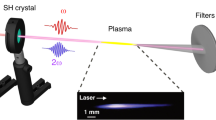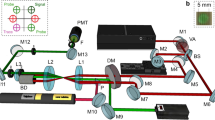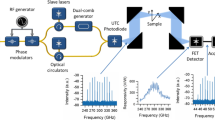Abstract
Terahertz wave sensing and imaging have received a great deal of attention because of their significant scientific and technological potential in multidisciplinary fields1,2,3. However, owing to the challenge of dealing with high ambient moisture absorption, the development of remote open-air broadband terahertz spectroscopy is lagging behind the urgent need for the technology that exists in homeland security and the fields of astronomy and environmental monitoring3,4. The requirement for on-site bias or forward collection of the optical signal in conventional terahertz detection techniques has inevitably prohibited their use in remote sensing5,6,7. We introduce an ‘all-optical’ technique of broadband terahertz wave detection by coherently manipulating the fluorescence emission from asymmetrically ionized gas plasma interacting with terahertz waves. Owing to the high atmospheric transparency and omnidirectional emission pattern of the fluorescence, this technique can be used to measure terahertz pulses at standoff distances with minimal water vapour absorption and unlimited directionality for optical signal collection. We demonstrate coherent terahertz wave detection at a distance of 10 m.
This is a preview of subscription content, access via your institution
Access options
Subscribe to this journal
Receive 12 print issues and online access
$209.00 per year
only $17.42 per issue
Buy this article
- Purchase on Springer Link
- Instant access to full article PDF
Prices may be subject to local taxes which are calculated during checkout





Similar content being viewed by others
References
Ferguson, B. & Zhang, X.-C. Materials for terahertz science and technology. Nature Mater. 1, 26–33 (2002).
Mittleman, D. Sensing with Terahertz Radiation (Springer, 2003).
Tonouchi, M., Cutting-edge terahertz technology. Nature Photon. 1, 97–105 (2007).
Federici, J. F. et al. THz imaging and sensing for security applications—explosives, weapons and drugs. Semicond. Sci. Technol. 20, S266–S280 (2005).
Exter, M. V., Fattinger, Ch. & Grischkowsky, D. High-brightness terahertz beams characterized with an ultrafast detector. Appl. Phys. Lett. 55, 337–339 (1989).
Wu, Q. & Zhang, X.-C. Free-space electro-optic sampling of terahertz beams. Appl. Phys. Lett. 67, 3523–3525 (1995).
Dai, J., Xie, X. & Zhang, X.-C. Detection of broadband terahertz waves with a laser-induced plasma in gases. Phys. Rev. Lett. 97, 103903 (2006).
Dai, J., Liu, J. & Zhang, X.-C. Terahertz wave air photonics: terahertz wave generation and detection with laser-induced gas plasma. IEEE J. Sel. Topics Quantum Electron. (in the press).
Dai, J., Karpowicz, N. & Zhang, X.-C. Coherent polarization control of terahertz waves generated from two-color laser-induced gas plasma. Phys. Rev. Lett. 103, 023001 (2009).
Liu, J. & Zhang, X.-C. Terahertz radiation enhanced emission of fluorescence from gas plasma. Phys. Rev. Lett. 103, 235002 (2009).
Corkum, P. B., Burnett, N. H. & Brunel, F. Above-threshold ionization in the long-wavelength limit. Phys. Rev. Lett. 62, 1259–1262 (1989).
Kresβ M. et al. Determination of the carrier-envelope phase of few-cycle laser pulses with terahertz-emission spectroscopy. Nature Phys. 2, 327–331 (2006).
Schumacher, D. W., Weihe, F., Muller, H. G. & Bucksbaum, P. H. Phase dependence of intense field ionization: a study using two colors. Phys. Rev. Lett. 73, 1344–1347 (1994).
Kim, K. Y., Taylor, A. J., Glownia, J. H. & Rordriguez, G. Coherent control of terahertz supercontinuum generation in ultrafast laser–gas interactions. Nature Photon. 2, 605–609 (2008).
Kulander, K. C., Schafer, K. J. & Krause, J. L. Dynamic stabilization of hydrogen in an intense, high-frequency, pulsed laser field. Phys. Rev. Lett. 66, 2601–2604 (1991).
Fedorov, M. V. Progress in Ultrafast Intense Laser Science Vol. I (Springer, 2006).
Talebpour, A., Liang, Y. & Chin, S. L. Population trapping in the CO molecule. J. Phys. B 29, 3435–3442 (1996).
Talebpour, A., Chien, C. Y. & Chin, S. L. Population trapping in rare gases. J. Phys. B 29, 5725–5733 (1996).
Azarm, A. et al. Direct observation of super-excited states in methane created by a femtosecond intense laser field. J. Phys. B 41, 225601 (2008).
Phelps, A. V. Rotational and vibrational excitation of molecules by low-energy electrons. Rev. Mod. Phys. 40, 399–410 (1968).
Filin, A., Compton, R., Romanov, D. A. & Levis, R. J. Impact-ionization cooling in laser-induced plasma filaments. Phys. Rev. Lett. 102, 155004 (2009).
Xu, H. L., Azarm, A., Bernhardt, J., Kamali, Y. & Chin, S. L. The mechanism of nitrogen fluorescence inside a femtosecond laser filament in air. Chem. Phys. 360, 171–175 (2009).
Wen, H. & Lindenberg, A. M. Coherent terahertz polarization control through manipulation of electron trajectories. Phys. Rev. Lett. 103, 023902 (2009).
Karpowicz, N. & Zhang, X.-C. Coherent terahertz echo of tunnel ionization in gases. Phys. Rev. Lett. 102, 093001 (2009).
Exter, M. V., Fattinger, Ch. & Grischkowsky, D. Terahertz time-domain spectroscopy of water vapor. Opt. Lett. 14, 1128–1130 (1989).
Dai, J. & Zhang, X.-C. Terahertz wave generation from gas plasma using a phase compensator with attosecond phase-control accuracy. Appl. Phys. Lett. 94, 021117 (2009).
Yeh, K.-L., Hoffmann, M. C., Hebling, J. & Nelson, K. A. Generation of 10 µJ ultrashort terahertz pulses by optical rectification. Appl. Phys. Lett. 90, 171121 (2007).
Ammosov, M. V., Delone, N. B. & Krainov, V. P. Tunnelling ionization of complex atoms and of atomic ions in an alternating electromagnetic field. Sov. Phys. JETP 64, 1191–1194 (1986).
McDaniel, E. W. Collision Phenomena in Ionized Gases (John Wiley & Sons, 1964).
Mlejnek, M., Wright, E. M. & Moleney, J. V. Moving-focus versus self-waveguiding model for long-distance propagation of femtosecond pulses in air. IEEE J. Quantum. Electron. 35, 1771–1776 (1999).
Acknowledgements
The authors thank N. Karpowicz for technical assistance and scientific discussions. We also gratefully acknowledge support from the National Science Foundation, Defense Threat Reduction Agency and the Department of Homeland Security through the DHS-ALERT Center under award no. 2008-ST-061-ED0001. The views and conclusions contained in this document are those of the authors and should not be interpreted as necessarily representing the official policies, either expressed or implied, of the U.S. Department of Homeland Security.
Author information
Authors and Affiliations
Contributions
J.L. designed the experiment and performed the simulation. J.D. designed the phase compensator and performed remote terahertz sensing. X.-C.Z. and S.L.C. provided theoretical analysis and guidance. X.-C.Z. initiated and supervised the project. All authors contributed to the final manuscript.
Corresponding author
Ethics declarations
Competing interests
The authors declare no competing financial interests.
Supplementary information
Rights and permissions
About this article
Cite this article
Liu, J., Dai, J., Chin, S. et al. Broadband terahertz wave remote sensing using coherent manipulation of fluorescence from asymmetrically ionized gases. Nature Photon 4, 627–631 (2010). https://doi.org/10.1038/nphoton.2010.165
Received:
Accepted:
Published:
Issue Date:
DOI: https://doi.org/10.1038/nphoton.2010.165
This article is cited by
-
High-frequency terahertz waves disrupt Alzheimer’s β-amyloid fibril formation
eLight (2023)
-
Intense multicycle THz pulse generation from laser-produced nanoplasmas
Scientific Reports (2023)
-
Detecting nanoparticles by “listening”
Frontiers of Physics (2023)
-
A room-temperature polarization-sensitive CMOS terahertz camera based on quantum-dot-enhanced terahertz-to-visible photon upconversion
Nature Nanotechnology (2022)
-
Enhanced coherent transition radiation from midinfrared-laser-driven microplasmas
Scientific Reports (2022)



